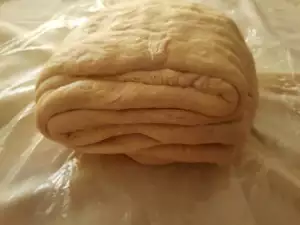How to make
Oven - 360°F (180°C);
A flat tray lined with baking paper.
Pour only the Manitoba flour into the mixer bowl.
Put the yeast in the warm milk and stir until it melts. Pour into the bowl with the flour and add half of the total sugar. Mix with the dough stirrers until a ball of dough forms and turn off the mixer. Cover and leave it to rise for 30/40 minutes.
After 40 minutes have passed, the dough is poured with all the water, the remaining sugar, the egg and the remaining flour according to the recipe are added. Mix again with the mixer, adding a little salt and grated lemon peel while mixing. Knead for about 15 minutes or until a ball of dough forms in a so-called clean bowl, meaning the dough has completely scraped the flour off the sides of the bowl and is fully kneaded.
Remove it from the bowl and transfer it onto a lightly floured surface. With a spatula it is turned several times without mixing further with your hands. Form into a smooth and elastic ball, return it into the same mixing bowl or another lightly greased bowl, cover and refrigerate it for 8 hours.
Leave the small amount of butter according to the recipe at room temperature, then place it between two pieces of baking paper and roll it out into a 6x6″ (15/15 cm) square. Leave the chunk of butter in the refrigerator to harden completely.
After 8 hours, take the chilled croissant dough out of the fridge and roll it out with a rolling pin into a long and medium narrow rectangle, which is about 8x18″ (20x45 cm) wide. Take a large piece of baking paper of the same length and sprinkle it with flour. The rolled out dough is transferred onto the floured paper. It is rolled out again to smooth out the creases that always occur when transferring. In the lower part of the rolled out strip of dough, the cold butter is placed. It is covered with the top of the dough.
The two sides of the dough are folded towards the middle, with the left side completely covering the right like a book, it is turned 190°F (90°C), covered with the baking paper and rolled out again into a strip. Remove the paper, fold it again like a book, sprinkle it with flour, cover it with the baking paper and roll it out into a strip again and shape it like a book again in the above way.
In this way, a small folded piece of dough is formed, which is wrapped in foil and left in the refrigerator for about 40 minutes, maybe more, the important thing is for the butter to harden completely.
The finished cooled dough is taken out and placed on flour and rolled out into a strip of 8x20″ (20x50 cm). With a knife, it is cut into triangles of the size of your choice.
Optionally, a chocolate bar can be placed at the base of each triangle or the croissants can be rolled directly, by pulling the top of the triangle when wrapping.
The shaped croissants are arranged in a baking tray. Let them rise at room temperature for about 40 to 60 minutes. Before putting them in the oven, do not spread them with egg or milk.
The Italian croissants are baked at 320°F (160°C) for about 10-15 minutes. The finished croissants are removed from the oven and spread with apricot jam or liquid honey.
Unlike the recipe for original French croissants, where the lamination of the dough is reduced to 6 times, this Italian recipe is times easier and faster, there is only one lamination, but of course - it also has its disadvantages. French croissants, after they are baked, they are airy, light and almost hollow inside and the individual layers of the puff pastry are very noticeable, while with these Italian croissants the dough is much more thicker, there are no hollows inside and they are denser, which makes them more like rolls, but still it feels like they are made of puff pastry - they have distinct layers of puff pastry.
Regardless of all I share, the recipe is nice but labor intensive for summer time, the butter softens easily and so does the dough and I forced myself during the rolling out process to cool the counter with a bag full of ice so I could shape it and roll it out correct.















